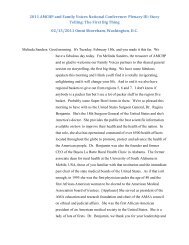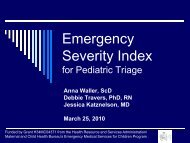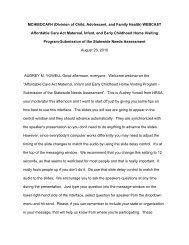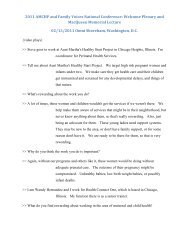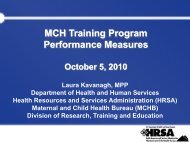Hormone Disruptors and Women's Health: Reasons for Concern [PDF]
Hormone Disruptors and Women's Health: Reasons for Concern [PDF]
Hormone Disruptors and Women's Health: Reasons for Concern [PDF]
You also want an ePaper? Increase the reach of your titles
YUMPU automatically turns print PDFs into web optimized ePapers that Google loves.
<strong>Hormone</strong> <strong>Disruptors</strong> <strong>and</strong> Women’s <strong>Health</strong><br />
<strong>Reasons</strong> <strong>for</strong> <strong>Concern</strong><br />
A woman’s body changes throughout her lifetime. Each stage<br />
of life, from fetal development to post-menopause, involves a<br />
direct relationship between her hormones <strong>and</strong> how her body<br />
develops <strong>and</strong> functions. When this relationship is in balance,<br />
it helps create the conditions <strong>for</strong> good health. When this relationship<br />
is out of balance, it can lead to a range of health<br />
problems that can be painful <strong>and</strong> devastating.<br />
Increasingly, the scientific evidence shows that some<br />
industrial chemicals, known as hormone disruptors, can<br />
throw off this balance. As a result, women can be at<br />
greater risk <strong>for</strong> experiencing health problems such as<br />
infertility <strong>and</strong> breast cancer.<br />
The Problem<br />
Over the last 70 years, more than 80,000 chemicals<br />
have been released into the environment<br />
through human activity. Because of inadequate<br />
health <strong>and</strong> safety laws, more than 85% of these<br />
chemicals have never been assessed <strong>for</strong> possible<br />
effects on human health. Although many of<br />
them may not cause harm, a significant number<br />
of those that have been tested are now believed<br />
to increase our risk <strong>for</strong> serious health problems.<br />
<strong>Hormone</strong> disruptors are one category of these<br />
chemicals that scientists are concerned about.<br />
Although many different chemicals can increase<br />
a woman’s risk <strong>for</strong> health problems, hormone disruptors<br />
are of particular concern because they can<br />
alter the critical hormonal balances required <strong>for</strong> proper<br />
health <strong>and</strong> development at all stages of a woman’s life.<br />
This brochure summarizes some of the latest peerreviewed<br />
science about the risks hormone disruptors pose to<br />
women <strong>and</strong> their reproductive health.
<strong>Hormone</strong>s <strong>and</strong> <strong>Hormone</strong> <strong>Disruptors</strong><br />
<strong>Hormone</strong>s regulate a wide range of functions in our bodies. <strong>Hormone</strong> disruptors* can interfere with these functions.<br />
What<br />
they are<br />
What<br />
they do<br />
<strong>Hormone</strong>s<br />
Clear Messages<br />
Pineal<br />
Parathyroids<br />
(behind thyroid gl<strong>and</strong>)<br />
Adrenal<br />
gl<strong>and</strong><br />
Kidney<br />
Duodenum<br />
Ovary<br />
<strong>Hormone</strong>s are produced by the endocrine system,<br />
which includes the ovaries (women), testes (men),<br />
pituitary, thyroid, pancreas <strong>and</strong> other parts of the body.<br />
They are then secreted into the blood as chemical<br />
Hypothalamus<br />
Pituitary gl<strong>and</strong><br />
messengers. Examples of hormones include adrenaline,<br />
estrogen, insulin, thyroid hormones <strong>and</strong> testosterone.<br />
<strong>Hormone</strong>s direct communication <strong>and</strong> coordination<br />
among tissues throughout the body. For example,<br />
hormones work with the nervous system, reproduc<br />
tive system, kidneys, gut, liver <strong>and</strong> fat to help maintain<br />
<strong>and</strong> control body energy levels, reproduction, growth<br />
<strong>and</strong> development, internal balance of body systems<br />
(called homeostasis) <strong>and</strong> responses to surroundings,<br />
stress <strong>and</strong> injury.<br />
* <strong>Hormone</strong> disruptors are also referred to as endocrine disruptors.<br />
Thyroid<br />
Thymus<br />
Stomach<br />
Pancreas<br />
<strong>Hormone</strong> <strong>Disruptors</strong><br />
Mixed Messages<br />
<strong>Hormone</strong> disruptors are substances not naturally<br />
found in the body that interfere with the production,<br />
release, transport, metabolism, binding, action or<br />
elimination of the body’s natural hormones. Phthal<br />
ates, Bisphenol A (BPA) <strong>and</strong> DDT are some of the more<br />
commonly known hormone disruptors.<br />
<strong>Hormone</strong> disruptors can scramble messages that<br />
natural hormones transfer between cells. Usually hormones<br />
bind to hormone receptors like a lock <strong>and</strong> key.<br />
When the key fits, it unlocks the process of sending<br />
messages to regulate functions in the body. <strong>Hormone</strong><br />
disruptors can interfere with this process. For example,<br />
some can mimic natural hormones <strong>and</strong> bind to the<br />
receptors, unlocking the process but sending the<br />
wrong message.<br />
The Complexity of <strong>Health</strong><br />
No <strong>for</strong>mula currently exists that can determine the exact effects hormone disruptors will have on a woman’s health. Research indicates<br />
that the effects depend on the potency <strong>and</strong> dose of the chemical, the timing of the exposure <strong>and</strong> the individual’s overall health,<br />
which can be shaped by her genetic makeup, diet, exercise habits, racial <strong>and</strong> economic disparities, sexually transmitted diseases,<br />
access to health care <strong>and</strong> many other factors.
How We Are Exposed<br />
People can be exposed to hormone disruptors indoors <strong>and</strong> outdoors, at home <strong>and</strong> in the workplace. <strong>Hormone</strong> disruptors get into<br />
our bodies when we breathe, eat, drink <strong>and</strong> have skin contact with them. They can be found in household products such as cosmetics<br />
<strong>and</strong> plastic containers. They can come from industrial pollution <strong>and</strong> cigarette smoke. Some pesticides are hormone disruptors<br />
<strong>and</strong> can end up on our food <strong>and</strong> in our waterways. Below are a few examples of hormone disruptors. More research is needed to<br />
identify all hormone disruptors <strong>and</strong> their potential health impacts.<br />
atrazine<br />
Cigarette<br />
Smoke<br />
First <strong>and</strong> Secondh<strong>and</strong><br />
Examples of <strong>Hormone</strong> <strong>Disruptors</strong><br />
Atrazine is one of the most heavily used herbicides in the U.S. <strong>and</strong> is widely applied to corn <strong>and</strong> soy crops. It is<br />
banned in the European Union due to concerns of ground water contamination.<br />
BPA Bisphenol A (BPA) is commonly used in some plastic products such as sports bottles <strong>and</strong> baby bottles, in addition<br />
to the linings of canned food <strong>and</strong> infant <strong>for</strong>mula.<br />
Cigarette smoke contains hundreds of chemicals, including some hormone disruptors. More research is needed<br />
to fully underst<strong>and</strong> how cigarette smoke affects hormone function. This research is especially important because<br />
cigarette smoke is very common <strong>and</strong> because so many health problems are associated with it.<br />
DDT The pesticide dichloro diphenyl trichloroethane (DDT) was widely used in the U.S. until it was banned in 1972 due<br />
to toxicity. DDE, a byproduct from the breakdown of DDT is also harmful. DDT is still used in some other countries,<br />
often to eliminate mosquitoes associated with malaria risk.<br />
DES Diethylstilbestrol (DES) is an estrogenic compound that was first manufactured in 1938 <strong>and</strong> was prescribed to<br />
prevent miscarriages. It is no longer used <strong>for</strong> this purpose because of the associated health risks.<br />
Dioxins Dioxins are the byproducts of some manufacturing <strong>and</strong> incineration processes. The uncontrolled burning of resi<br />
dential waste is thought to be among the largest sources of dioxins in the United States.<br />
PBBs Polybrominated biphenyls (PBBs) were used as a flame retardant in electrical appliances, textiles, plastic<br />
foams <strong>and</strong> other products. In 1976 the manufacturing of PBBs ended in the U.S. after they contaminated<br />
milk supplies.<br />
PCBs Polychlorinated biphenyls (PCBs) are a class of compounds that were used as coolants <strong>and</strong> insulation in electrical<br />
equipment, in coating of electrical wiring <strong>and</strong> <strong>for</strong> many other purposes. They were banned in the 1970s due to<br />
their toxicity.<br />
Phthalates Phthalates are a family of compounds used as a plasticizer in PVC (vinyl), cosmetics, fragrance <strong>and</strong> medical<br />
devices. Some phthalates were banned from children’s products in 2008.<br />
Some hormone disruptors such as DDT <strong>and</strong> PCBs were banned more than<br />
30 years ago but persist in the environment, animals <strong>and</strong> our bodies.
Women’s Reproductive <strong>Health</strong> <strong>Concern</strong>s<br />
Animal studies designed to predict human harm, as well as a limited number of human studies, have helped researchers underst<strong>and</strong><br />
some of the ways hormone disruptors can increase risk <strong>for</strong> various health problems. More research is needed, but below are descriptions<br />
of some of these health problems <strong>and</strong> examples of associated hormone disruptors (in italics).<br />
Early puberty is a growing concern. In<br />
the U.S. girls get their first periods a few<br />
months earlier than they did 40 years<br />
ago, <strong>and</strong> they develop breasts one to<br />
two years earlier. Early puberty has<br />
been associated with polycystic ovarian<br />
syndrome, obesity, breast cancer,<br />
depression <strong>and</strong> a number of social challenges<br />
such as experimentation with<br />
sex, alcohol or drugs at a younger age.<br />
Phthalates, BPA, some pesticides such as<br />
DDT, PCBs, PBBs, cigarette smoke <strong>and</strong><br />
DES.<br />
Impaired fertility or infertility<br />
includes difficulty or the inability to get<br />
pregnant <strong>and</strong>/or carry a pregnancy to<br />
term. It is difficult to say <strong>for</strong> certain how<br />
many people experience impaired fertility,<br />
but the best estimate is 12% of the<br />
reproductive age population in the U.S.<br />
This number seems to have increased<br />
over the last two decades, most sharply<br />
in women under the age of 25. Menstrual<br />
irregularities <strong>and</strong> male infertility<br />
contribute to this problem, as well as<br />
other specific health concerns, which<br />
are listed below. DDT, cigarette smoke,<br />
phthalates <strong>and</strong> PCBs.<br />
Polycystic ovarian syndrome (PCOS)<br />
symptoms include irregular periods, pelvic<br />
pain <strong>and</strong> ovarian cysts. Women with<br />
PCOS have a higher risk of developing<br />
insulin resistance, diabetes, endometrial<br />
cancer, infertility, miscarriage <strong>and</strong><br />
hypertension. BPA.<br />
Uterine fibroids occur in 25% to 50%<br />
of all women, though some estimates<br />
are much higher. Fibroids are the number<br />
one cause of hysterectomy in reproductive<br />
age women <strong>and</strong> can cause pelvic<br />
pain, abnormally heavy periods, abnormal<br />
uterine bleeding, infertility <strong>and</strong> complications<br />
in pregnancy. DES <strong>and</strong> BPA.<br />
Endometriosis occurs when the tissue<br />
that lines the inside of the uterus (called<br />
the endometrium) grows outside the<br />
uterus on other parts of the body, <strong>for</strong><br />
example the ovaries, abdomen <strong>and</strong> pelvis.<br />
Estimates vary, but most studies find<br />
between 10% <strong>and</strong> 15% of reproductiveage<br />
women have endometriosis. About<br />
30% to 40% of women with endometriosis<br />
are infertile, making it one of the<br />
leading contributors to female infertility.<br />
DES, dioxins, phthalates <strong>and</strong> PCBs.<br />
Miscarriage affects up to 21% of<br />
known pregnancies <strong>and</strong> can be caused<br />
by a variety of factors, especially abnormal<br />
chromosomes (known as aneuploidy).<br />
BPA, cigarette smoke <strong>and</strong> pesticides<br />
such as DDT.<br />
Shortened lactation, or reducing<br />
how long a woman can breastfeed her<br />
baby, can have longterm impacts on<br />
the child, including increased risk <strong>for</strong><br />
infection, chronic disease, compromised<br />
immunity <strong>and</strong> obesity. Breastfeeding<br />
helps build a child’s immune system<br />
<strong>and</strong> later intelligence <strong>and</strong> is important<br />
to the bonding <strong>and</strong> nurturing process.<br />
PCBs <strong>and</strong> pesticides such as Atrazine or<br />
DDT/DDE.<br />
Breast cancer incidence rates in the<br />
United States increased by more than<br />
40% between 1973 <strong>and</strong> 1998. In 2008, a<br />
woman’s lifetime risk of breast cancer<br />
is one in eight. More than 200 chemicals,<br />
including numerous hormone<br />
disruptors, have been associated with<br />
increased incidence of breast tumors.<br />
DES, BPA, first- or second-h<strong>and</strong> smoke <strong>and</strong><br />
some pesticides, especially early life exposure<br />
to DDT.<br />
<strong>Hormone</strong> <strong>Disruptors</strong> <strong>and</strong> Men’s<br />
<strong>Health</strong>. This report focuses on the risks<br />
of hormone disruptors <strong>and</strong> women’s<br />
health, but these chemicals also pose<br />
risks to males, especially from exposures<br />
in the womb. Some of these risks include<br />
hypospadias (a birth defect of the penis),<br />
cryptochordism (undescended testicles),<br />
impaired fertility from reduced sperm<br />
count <strong>and</strong> semen quality, <strong>and</strong> some<br />
cancers, including testicular <strong>and</strong> prostate<br />
cancer.<br />
<strong>Hormone</strong> disruptors are not the only<br />
type of chemicals that can harm women’s<br />
health. Solvents, air pollution, heavy<br />
metals such as lead <strong>and</strong> mercury <strong>and</strong><br />
many other contaminants can harm<br />
people’s health. To learn about other<br />
environmental contaminants, see the<br />
references at the end of this brochure.
What We Are Learning<br />
Research into hormone disruptors is changing our underst<strong>and</strong>ing of health risks. Traditional schools of thought are evolving to<br />
reflect the complexity of how chemicals impact our health. Some trends in the research findings include:<br />
Timing of Exposure<br />
Throughout a woman’s lifetime, reproductive organs develop <strong>and</strong> change. Stages of rapid development<br />
can be especially vulnerable to the effects of hormone disruptors, <strong>and</strong> exposure at these times<br />
can increase risk <strong>for</strong> health problems later in life. For example, exposure to some hormone disruptors<br />
be<strong>for</strong>e birth can increase the chance <strong>for</strong> early puberty, infertility <strong>and</strong> breast cancer.<br />
Generational Effects<br />
<strong>Hormone</strong> disruptors can cause multigenerational harm. The clearest example of this is DES, a drug<br />
given to pregnant women <strong>for</strong> many years to prevent miscarriage (though it was ineffective). Many<br />
DES daughters experience infertility <strong>and</strong> cancer in their reproductive organs <strong>and</strong> breasts. Animal studies<br />
show that the gr<strong>and</strong>daughters of women who took DES are also at risk <strong>for</strong> ovarian <strong>and</strong> uterine<br />
cancers.<br />
Level of Exposure<br />
For years it was assumed that everyday levels of chemical exposure would not harm our health, but<br />
emerging research calls this into question. For example, some studies have found that low levels of<br />
BPA can harm reproductive health in female mice <strong>and</strong> their offspring. More research is needed to fully<br />
underst<strong>and</strong> how BPA impacts humans, but the Centers <strong>for</strong> Disease Control detected BPA in nearly 93%<br />
of the people they tested, raising new questions about its widespread use.<br />
<strong>Hormone</strong> Activation Levels. Natural or synthetic hormones can activate changes at very low levels. This graph shows normal levels of natural estrogen<br />
(estradiol) in women <strong>and</strong> levels of synthetic estrogen (ethinyl estradiol) <strong>and</strong> progestin (desogestrel) in women taking birth control. These levels are adequate to<br />
activate significant functions, such as regulating menstrual cycles <strong>and</strong> preventing pregnancy. BPA, which can mimic natural estrogen, can be found in the body under<br />
normal conditions at the same or higher levels than these natural or synthetic hormones.<br />
Natural estrogen in women<br />
of reproductive years<br />
Synthetic estrogen in women<br />
using birth control pills<br />
Synthetic progestin in women<br />
using birth control pills*<br />
BPA in women<br />
Levels (parts per trillion)<br />
* Levels of 3-keto-desogestrel, the metabolite of desogestrel.<br />
0 100 200 300 400 500 600 700 800 900 1000 4010
What We Can Do<br />
We know enough about hormone disruptors to know we have a problem. A coordinated ef<strong>for</strong>t between researchers, elected<br />
officials, advocates, medical professionals, business leaders <strong>and</strong> the general public is needed to ensure that we are not putting<br />
our families <strong>and</strong> future generations at undue risk. Some of the things we can do are:<br />
Support better research on hormone disruptors, including:<br />
• Prioritize research funding to study the effects of hormone disruptors on women’s health. Most of the research to date has been<br />
focused on hormone disruptors <strong>and</strong> men, leaving more gaps in the research on women’s health.<br />
• Improve health tracking systems. Currently the systems that track rates of various health problems are inadequate. In order<br />
to underst<strong>and</strong> the full impact of hormone disruptors on human health, collecting this in<strong>for</strong>mation is critical.<br />
• Support long-term studies. Because hormone disruptors can have lifelong impacts, it is especially important to initiate studies<br />
tracking women’s health over large spans of their lives. This will help us underst<strong>and</strong> longterm <strong>and</strong> multigenerational<br />
effects.<br />
Support policies to prevent exposure to hormone disruptors <strong>and</strong> other chemicals that have not been proven<br />
safe. Current st<strong>and</strong>ards <strong>for</strong> chemical use do not adequately protect us. New national policies are needed to identify <strong>and</strong><br />
phase out harmful chemicals <strong>and</strong> to require that safer substitutes be used.<br />
Use healthier products when possible. There are many easy, af<strong>for</strong>dable <strong>and</strong> simple changes anyone can make at<br />
home to reduce their exposure to environmental contaminants. For ideas on how to make these changes, please see<br />
www.womenshealth<strong>and</strong>environment.org.<br />
References<br />
References <strong>for</strong> this report were taken from peerreviewed<br />
sources that summarize the links between hormone disruptors<br />
<strong>and</strong> women’s heath. The primary source was:<br />
Crain, AD, Janssen, S. et al. Female reproductive disorders:<br />
The roles of endocrine disrupting compounds <strong>and</strong><br />
developmental timing. Fertility <strong>and</strong> Sterility; expected<br />
publication Fall 2008.<br />
Other references used to support the development of<br />
this report include:<br />
Proceedings from the Summit on Environmental Challenges<br />
to Reproductive <strong>Health</strong> <strong>and</strong> Fertility. Hosted by<br />
the University of Cali<strong>for</strong>nia, San Francisco <strong>and</strong> the Collaborative<br />
on <strong>Health</strong> <strong>and</strong> the Environment. Fertility<br />
<strong>and</strong> Sterility 2008;89:e1e20. www.prhe.ucsf.edu/prhe/<br />
events/ucsfche_fs.html.<br />
Shaping Our Legacy: Reproductive <strong>Health</strong> <strong>and</strong> the Environment.<br />
A report on the Summit on Environmental<br />
Challenges to Reproductive <strong>Health</strong> <strong>and</strong> Fertility, January<br />
28–30, 2007. www.prhe.ucsf.edu/prhe/pubs/shapingourlegacy.pdf.<br />
These <strong>and</strong> many other resources document how hormone<br />
disruptors <strong>and</strong> a wide range of other contaminants<br />
can harm people’s health. For full documentation<br />
of this brochure, see www.health<strong>and</strong>environment.org/<br />
reprohealthworkshop.<br />
This report summarizes the key outcomes of the Women’s Reproductive <strong>Health</strong> <strong>and</strong> the<br />
Environment Workshop held at Commonweal in Bolinas, CA, January 6–9, 2008. Results<br />
are published in “Female reproductive disorders: The roles of endocrine disrupting compounds<br />
<strong>and</strong> developmental timing.” (See References <strong>for</strong> full citation).<br />
The workshop was cosponsored by the Collaborative on <strong>Health</strong> <strong>and</strong> the Environment<br />
(CHE), the University of Florida (UF) <strong>and</strong> the University of Cali<strong>for</strong>nia, San Francisco’s Program<br />
on Reproductive <strong>Health</strong> <strong>and</strong> the Environment (PRHE). This event was cochaired<br />
by Dr. Louis Guillette at UF (www.zoology.ufl.edu/ljg) <strong>and</strong> Dr. Linda Giudice at PRHE<br />
(www.prhe.ucsf.edu). Please contact these individuals <strong>for</strong> further in<strong>for</strong>mation about this<br />
research. Thanks to Sarah Janssen of Natural Resources Defense Council <strong>for</strong> contributing<br />
to this brochure. Written by Heather Sarantis.<br />
Funding <strong>for</strong> this project was provided by John Burbank <strong>and</strong> Alison Carlson, the Barbara<br />
Smith Fund, the Johnson Family Foundation, The New York Community Trust <strong>and</strong> Turner<br />
Foundation, Inc.<br />
For copies of this brochure or <strong>for</strong> more in<strong>for</strong>mation please contact CHE (www.<br />
health<strong>and</strong>environment.org).<br />
Printed on New Leaf Reincarnation Matte paper. FSCcertified, 100% recycled, 50% postconsumer content, processed chlorine free.<br />
Design by halffull (www.halffull.org).<br />
• COLLABORATIVE ON HEALTH AND THE ENVIRONMENT


![Hormone Disruptors and Women's Health: Reasons for Concern [PDF]](https://img.yumpu.com/19410002/1/500x640/hormone-disruptors-and-womens-health-reasons-for-concern-pdf.jpg)

